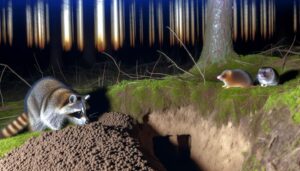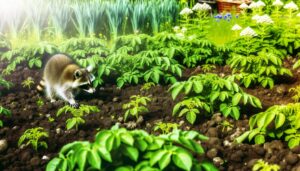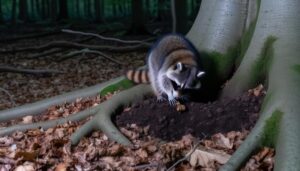Do Raccoons Eat Koi Fish?
Raccoons are indeed predators of koi fish, leveraging their dexterity and intelligence to capture these vibrant and slower-moving targets. They are strongly attracted to koi ponds by the scent of the water and the movement of the fish, which mimic their natural hunting environments.
Indicators of raccoon activity include scattered fish scales and overturned aquatic plants. The vulnerability of koi fish is heightened due to their bright colors and lack of natural camouflage.
Effective protective measures, such as fencing and motion-activated deterrents, are essential to mitigate raccoon predation risks on koi fish. Crafting thorough strategies to protect your pond is essential.
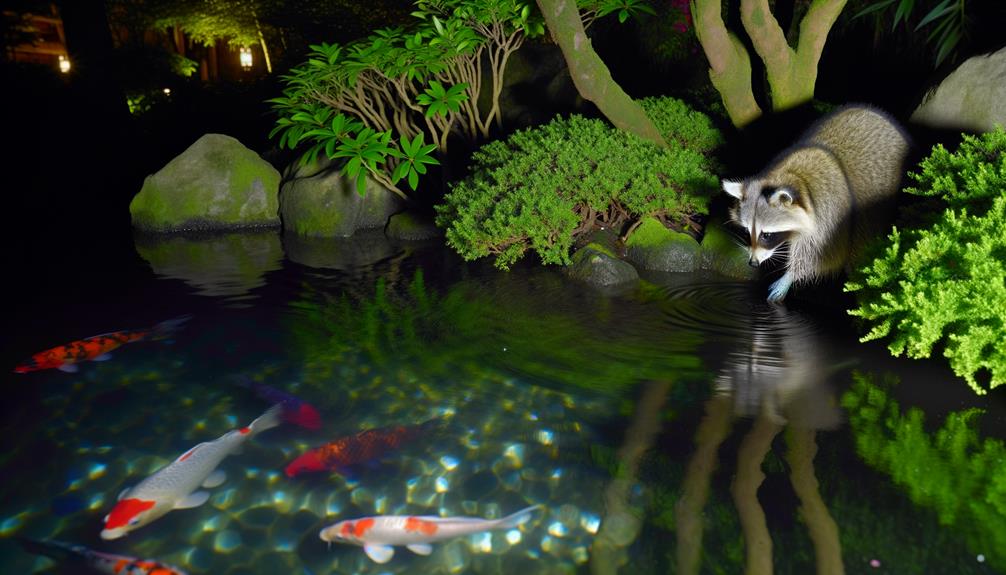
Key Takeaways
- Raccoons are attracted to koi ponds by the scents and sounds of water and fish.
- Koi fish are vulnerable to raccoon predation due to their bright colors and slow swimming speeds.
- Raccoons use their dexterous front paws to effectively capture koi fish.
- Recognizing signs of raccoon activity, such as scattered fish scales and overturned plants, is crucial for protection.
- Protective measures like fencing, netting, and deeper pond sections help deter raccoons from accessing koi fish.
Understanding Raccoon Behavior
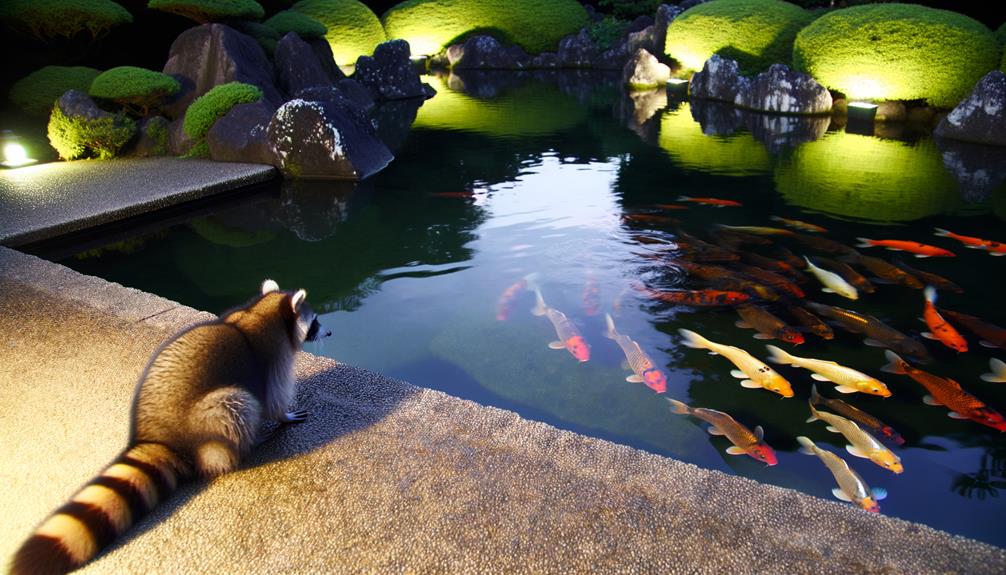
Raccoons (Procyon lotor) exhibit highly adaptable and opportunistic feeding behaviors, which play an essential role in their ability to thrive in diverse environments. These nocturnal mammals possess remarkable dexterity and problem-solving abilities, enabling them to exploit a wide array of food sources.
Their behavior is characterized by keen curiosity and a high level of intelligence, which facilitates their interactions with various habitats, from urban settings to wilderness areas. Their foraging strategies are flexible; they can both scavenge and actively hunt, depending on the availability of resources.
Their behaviors are also influenced by seasonal changes, prompting shifts in activity patterns and dietary intake. Understanding these behavioral traits is vital for comprehending their interactions with specific prey, such as koi fish.
Raccoons' Diet Preferences
Raccoons exhibit omnivorous eating habits, consuming a wide range of plant and animal matter. Their diet is highly opportunistic, often influenced by the availability of food sources in their immediate environment.
Additionally, raccoons' dietary preferences can vary seasonally, adapting to the changing availability of resources throughout the year.
Omnivorous Eating Habits
As omnivores, raccoons exhibit a diverse dietary palette that includes a variety of animal and plant-based foods, reflecting their adaptability to different environments. Their diet typically comprises fruits, nuts, insects, small mammals, amphibians, and bird eggs.
Additionally, raccoons forage for aquatic prey such as crayfish, frogs, and fish. This dietary diversity is supported by their highly developed sensory and manipulative abilities, allowing them to exploit a wide range of food sources.
Seasonal variations also influence their food choices; for instance, they consume more plant material in the summer and fall and rely more on animal prey in the winter and spring. This flexible diet underscores their ecological success and capacity to thrive in various habitats, from urban to rural landscapes.
Opportunistic Food Choices
Given their highly adaptable nature, raccoons exhibit opportunistic feeding behaviors that allow them to exploit a wide range of food sources depending on availability. Their diet includes fruits, nuts, insects, small mammals, and aquatic organisms. Raccoons have a particular affinity for foraging in aquatic environments, where they can find crustaceans, amphibians, and fish.
This adaptability is facilitated by their highly developed tactile sense and dexterous front paws, which enable them to manipulate objects and access various food items. Additionally, raccoons possess acute night vision, enhancing their ability to hunt and forage under low-light conditions.
Their opportunistic tendencies make them capable of adapting to both urban and rural environments, thereby increasing their chances of survival across diverse habitats.
Seasonal Diet Variations
Seasonal fluctuations in food availability greatly influence the dietary preferences and foraging behavior of raccoons. During different times of the year, raccoons adapt their diets to optimize nutrient intake and energy conservation.
In spring and summer, raccoons consume a variety of foods, including fruits, insects, and small mammals. As autumn approaches, their diet shifts to high-calorie nuts and seeds to build fat reserves for winter.
In winter, raccoons' activity decreases, and they rely on:
- Reserved body fat for energy.
- Scavenged carrion or human-provided food sources.
- Occasional aquatic prey, such as fish, when accessible.
These dietary adjustments secure raccoons meet their nutritional needs throughout the year, reflecting their opportunistic and adaptable nature.
Attraction to Koi Ponds
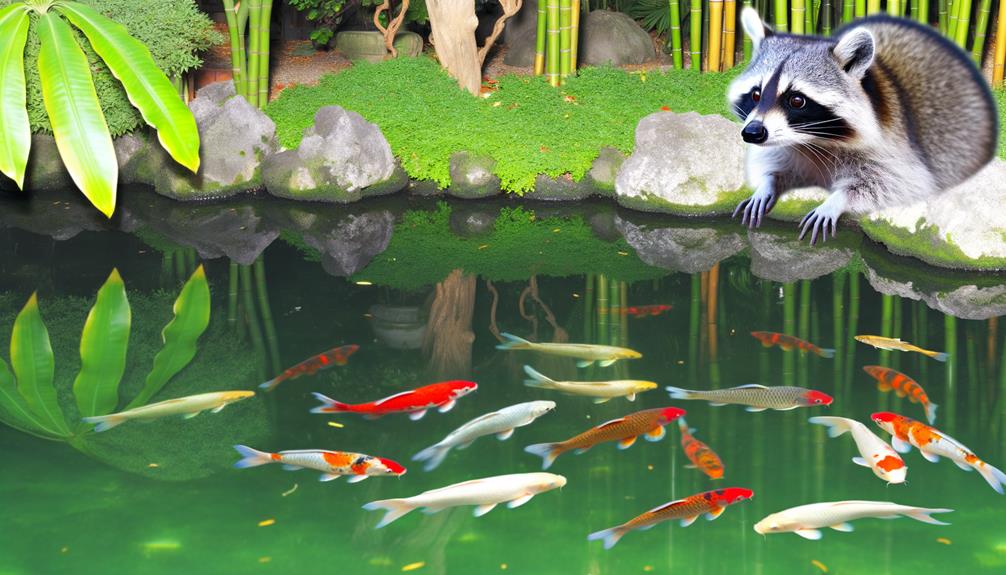
Raccoons are often attracted to koi ponds due to the distinct scents emanating from the water and the fish.
Additionally, the sounds of water movement can serve as an auditory lure, signaling a potential food source.
These sensory stimuli play a significant role in drawing raccoons to environments where koi are present.
Koi Pond Scents
Intriguingly, the specific scents emanating from koi ponds, including the aroma of water, aquatic plants, and fish, play an important role in attracting raccoons. This olfactory allure can be attributed to several factors:
- Aquatic Plant Aromas: Plants such as water lilies and lotus release organic compounds, which can be highly appealing to raccoons.
- Fish Odor: The natural scent of koi fish, especially when injured or stressed, can attract raccoons, who are opportunistic feeders.
- Water Scent: The unique smell of pond water, influenced by algae and microorganisms, adds to the overall attraction.
Understanding these scent factors is vital for koi pond owners aiming to mitigate raccoon predation, facilitating more effective protective measures.
Water Movement Sounds
In addition to the olfactory allure of koi ponds, the auditory stimuli generated by water movement can also greatly attract raccoons.
The sound of flowing or splashing water mimics natural streams or rivers, environments where raccoons commonly forage. These sounds signal the presence of a potential food source, prompting raccoons to investigate further.
Water movement may also indicate the presence of fish, amphibians, or other aquatic prey, which are essential to the raccoon diet. The auditory cues serve as a beacon, drawing raccoons towards the pond.
Understanding this attraction is essential for pond owners aiming to protect their koi, as it highlights the need for implementing deterrents not only against scent but also against sound.
Signs of Raccoon Activity
Evidence of raccoon presence around koi ponds can be identified through various indicators such as scattered fish scales, overturned plants, and distinctive paw prints. These nocturnal animals often leave behind clear signs of their activity, which can be essential for pond owners to recognize.
Key indicators include:
- Scattered Fish Scales: Raccoons, in their attempts to catch koi, often leave fish scales around the pond area.
- Overturned Plants: Searching for food, raccoons may disrupt aquatic vegetation, leaving plants uprooted or overturned.
- Distinctive Paw Prints: Raccoon paw prints are easily distinguishable, typically showing five toes with noticeable claw marks.
Recognizing these signs can help in implementing timely measures to protect koi fish from raccoon predation.
Koi Fish Vulnerability
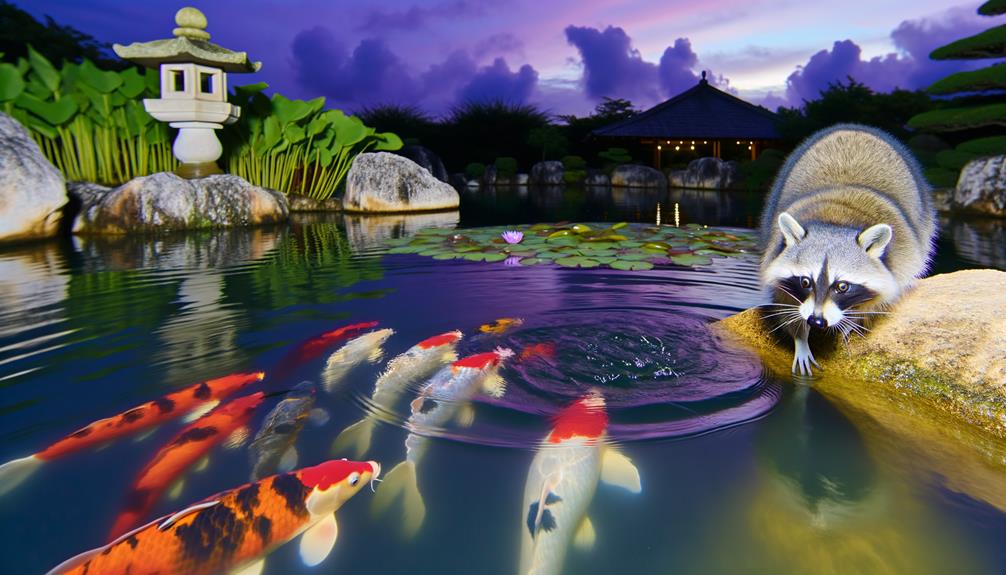
Koi fish are particularly vulnerable to raccoon predation due to their bright colors, which make them highly visible in pond environments, and their relatively slow swimming speeds. This visibility, while aesthetically pleasing to human observers, unfortunately increases the risk of predation.
In addition, koi fish tend to swim near the water's surface, a behavior that further exposes them to terrestrial predators like raccoons. Their lack of natural camouflage and slower escape responses compared to other fish make them easy targets.
Besides, raccoons possess dexterous front paws, enabling them to effectively capture koi. These factors collectively contribute to the heightened vulnerability of koi fish, necessitating careful consideration of protective measures to mitigate predation risks.
Pond Design Considerations
Effective pond design plays an essential role in minimizing the risk of raccoon predation on koi fish. Key considerations include:
- Depth: A pond depth of at least 3 feet is recommended, as raccoons are less inclined to wade into deeper waters.
- Shelters: Incorporating rock caves or overhangs provides hiding spots for koi, reducing their exposure to potential predators.
- Perimeter Barriers: Steep or vertical pond edges can deter raccoons from accessing the water.
These elements collectively create a hostile environment for raccoons, safeguarding koi fish. By incorporating such design features, pond owners can reduce the likelihood of predation while maintaining an aesthetically pleasing and ecologically balanced habitat for their koi.
Deterring Raccoons

Deterring raccoons from accessing koi ponds involves the strategic implementation of various protective measures. Utilizing protective pond barriers, motion-activated deterrents, and natural predator scents can effectively reduce raccoon intrusions.
Each method offers unique advantages and can be tailored to the specific needs of the pond environment.
Protective Pond Barriers
Implementing protective pond barriers is a scientifically proven method to reduce the risk of raccoons accessing and preying on koi fish. These barriers serve as physical deterrents, preventing raccoons from reaching the pond.
To maximize effectiveness, consider the following strategies:
- Fencing: Install a sturdy fence with a minimum height of 3 feet around the pond. Make sure the fence is buried at least 6 inches underground to prevent raccoons from digging underneath.
- Netting: Use pond netting to cover the water surface. This creates a physical barrier that raccoons cannot penetrate.
- Pond Depth: Design ponds with deeper sections (minimum 3 feet) to make it challenging for raccoons to wade in and catch the fish.
These methods collectively enhance koi fish protection.
Motion-Activated Deterrents
In addition to physical barriers, motion-activated deterrents offer a dynamic solution to discourage raccoons from approaching koi ponds. These devices utilize sensors to detect movement, subsequently triggering mechanisms such as lights, sounds, or water sprays to startle and repel the animals. Scientific studies indicate that such deterrents can notably reduce raccoon activity around sensitive areas. The following table outlines various types of motion-activated deterrents and their characteristics:
| Deterrent Type | Primary Mechanism |
|---|---|
| Ultrasonic Repellers | High-pitched sounds |
| Water Sprayers | Burst of water |
| Flashing Lights | Intense light bursts |
| Sonic Alarms | Loud noises |
| Combination Devices | Multiple mechanisms |
Effectively integrating these methods can enhance the protection of koi ponds, minimizing the risk of predation by raccoons.
Natural Predator Scents
Utilizing natural predator scents can serve as an effective strategy to deter raccoons from koi ponds, leveraging their instinctual fear of larger predators. These scents can mimic the presence of animals such as coyotes or foxes, creating an environment perceived as unsafe by raccoons.
Scientific studies suggest that predator scents can notably reduce raccoon activity when applied correctly.
Key considerations include:
- Selection of Scent: Use scents from natural raccoon predators, such as coyote urine or fox urine, which are commercially available.
- Application Method: Apply the scent around the perimeter of the koi pond, focusing on entry points.
- Frequency of Reapplication: Regular reapplication is necessary, especially after rain, to maintain the deterrent effect.
Protective Pond Barriers
To effectively safeguard koi fish from raccoon predation, installing protective pond barriers is a critical measure that encompasses various structural and material considerations. These barriers can include physical deterrents such as netting, wire mesh, and electric fencing.
Netting should be securely fastened and cover the entire pond surface to prevent raccoons from accessing the water. Wire mesh, with small enough gaps to deter raccoon paws, can be installed around the perimeter. Electric fencing, when used responsibly, can provide an additional deterrent by delivering a mild shock.
Additionally, placing barriers at least two feet high and burying them several inches underground can prevent raccoons from climbing over or digging under. Employing such strategies ensures a multi-faceted defense against raccoon intrusions.
Natural Predators and Risks
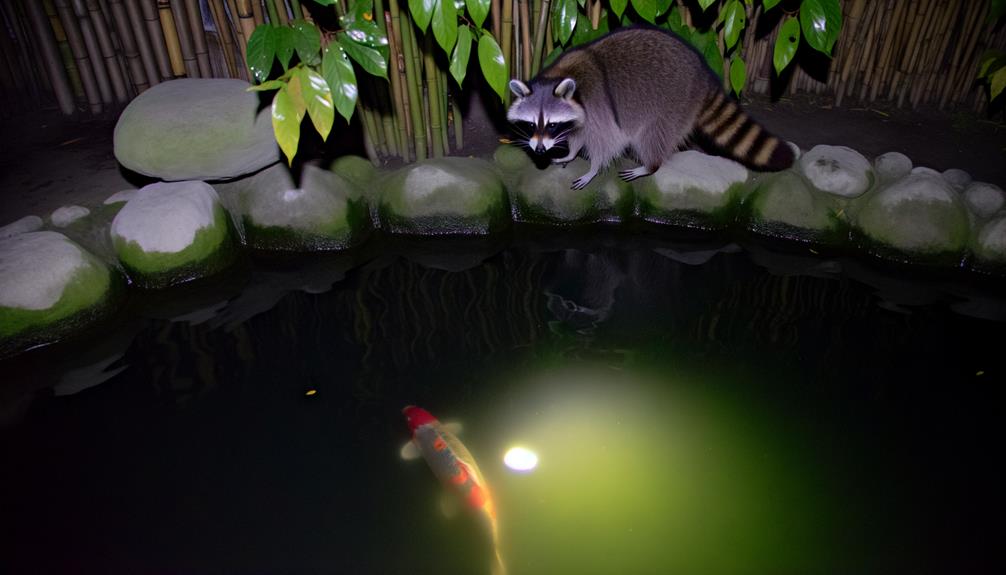
Understanding the intricate dynamics of natural predators and environmental risks is vital for ensuring the safety of koi fish in outdoor ponds. Koi fish are vulnerable to a variety of predators and environmental challenges. Common natural predators include raccoons, herons, and domestic cats.
Additionally, environmental factors such as water quality and habitat structure play an essential role.
Consider the following primary risks:
- Predatory Animals: Raccoons, herons, and cats often pose significant threats to koi fish, exploiting shallow areas for access.
- Water Quality: Poor water conditions can weaken koi, making them more susceptible to predation and disease.
- Habitat Design: Insufficient hiding spaces and inadequate pond depth increase koi vulnerability.
Monitoring and Maintenance
Effective surveillance and upkeep of koi ponds are critical to guaranteeing the health and safety of koi fish. Regular inspections should be conducted to identify potential threats, such as raccoon activity, which can endanger the fish.
Use motion-activated cameras to monitor nocturnal activities around the pond. Additionally, maintaining water quality through consistent filtration and aeration is essential. Check for signs of water contamination and adjust pH levels as needed.
Pond barriers, such as netting or fencing, can deter predators. Ensure the pond environment is ideal by trimming overhanging vegetation that provides cover for raccoons.
Regularly review the structural integrity of the pond to prevent any breaches that could facilitate predator access. Through diligent surveillance and upkeep, koi fish can thrive in a safe habitat.
Expert Advice and Resources
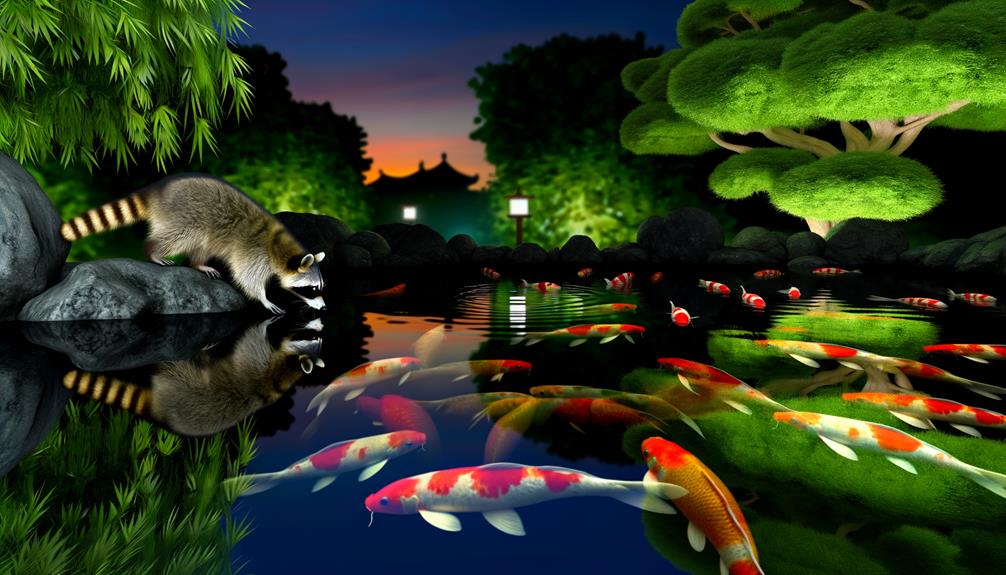
Consulting with aquatic biologists and professional koi breeders can provide invaluable insights into safeguarding koi fish from predators such as raccoons. Their expertise is essential for creating effective, science-based protective strategies.
- Habitat Design: Experts recommend designing ponds with steep sides and sufficient depth to deter raccoons, who generally avoid deep water.
- Protective Barriers: Installation of physical barriers such as netting or fencing can prevent raccoon access. These should be designed to withstand the dexterity and determination of raccoons.
- Behavioral Insights: Understanding raccoon behavior, such as their foraging patterns and nocturnal activity, can help in timing deterrents like motion-activated lights or sprinklers.
These measures, grounded in expert consultation, enhance the security of koi habitats against raccoon predation.
Conclusion
In sum, raccoons exhibit a diverse diet that includes koi fish, making ornamental ponds susceptible to their predation. The presence of raccoons can be ascertained through specific signs of activity, and koi fish are particularly vulnerable.
Implementing protective barriers and regular maintenance can mitigate these risks. Like sentinels guarding a fortress, vigilant monitoring and proactive measures are essential.
Expert resources provide further guidance, ensuring the well-being of koi ponds amidst the myriad challenges posed by natural predators.

